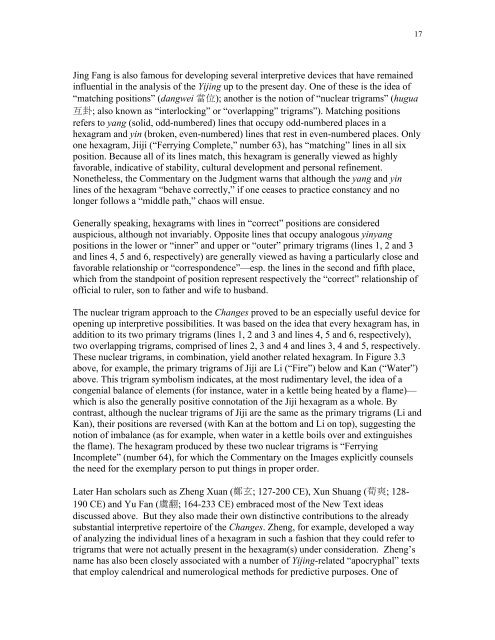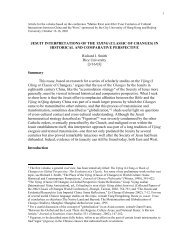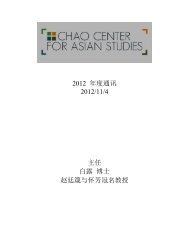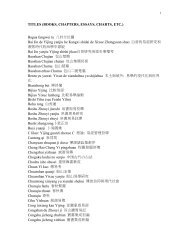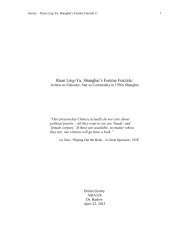Key Concepts of Fate and Prediction in the Yijing - Chao Center for ...
Key Concepts of Fate and Prediction in the Yijing - Chao Center for ...
Key Concepts of Fate and Prediction in the Yijing - Chao Center for ...
You also want an ePaper? Increase the reach of your titles
YUMPU automatically turns print PDFs into web optimized ePapers that Google loves.
17J<strong>in</strong>g Fang is also famous <strong>for</strong> develop<strong>in</strong>g several <strong>in</strong>terpretive devices that have rema<strong>in</strong>ed<strong>in</strong>fluential <strong>in</strong> <strong>the</strong> analysis <strong>of</strong> <strong>the</strong> Yij<strong>in</strong>g up to <strong>the</strong> present day. One <strong>of</strong> <strong>the</strong>se is <strong>the</strong> idea <strong>of</strong>“match<strong>in</strong>g positions” (dangwei ); ano<strong>the</strong>r is <strong>the</strong> notion <strong>of</strong> “nuclear trigrams” (hugua; also known as “<strong>in</strong>terlock<strong>in</strong>g” or “overlapp<strong>in</strong>g” trigrams”). Match<strong>in</strong>g positionsrefers to yang (solid, odd-numbered) l<strong>in</strong>es that occupy odd-numbered places <strong>in</strong> ahexagram <strong>and</strong> y<strong>in</strong> (broken, even-numbered) l<strong>in</strong>es that rest <strong>in</strong> even-numbered places. Onlyone hexagram, Jiiji (“Ferry<strong>in</strong>g Complete,” number 63), has “match<strong>in</strong>g” l<strong>in</strong>es <strong>in</strong> all sixposition. Because all <strong>of</strong> its l<strong>in</strong>es match, this hexagram is generally viewed as highlyfavorable, <strong>in</strong>dicative <strong>of</strong> stability, cultural development <strong>and</strong> personal ref<strong>in</strong>ement.None<strong>the</strong>less, <strong>the</strong> Commentary on <strong>the</strong> Judgment warns that although <strong>the</strong> yang <strong>and</strong> y<strong>in</strong>l<strong>in</strong>es <strong>of</strong> <strong>the</strong> hexagram “behave correctly,” if one ceases to practice constancy <strong>and</strong> nolonger follows a “middle path,” chaos will ensue.Generally speak<strong>in</strong>g, hexagrams with l<strong>in</strong>es <strong>in</strong> “correct” positions are consideredauspicious, although not <strong>in</strong>variably. Opposite l<strong>in</strong>es that occupy analogous y<strong>in</strong>yangpositions <strong>in</strong> <strong>the</strong> lower or “<strong>in</strong>ner” <strong>and</strong> upper or “outer” primary trigrams (l<strong>in</strong>es 1, 2 <strong>and</strong> 3<strong>and</strong> l<strong>in</strong>es 4, 5 <strong>and</strong> 6, respectively) are generally viewed as hav<strong>in</strong>g a particularly close <strong>and</strong>favorable relationship or “correspondence”—esp. <strong>the</strong> l<strong>in</strong>es <strong>in</strong> <strong>the</strong> second <strong>and</strong> fifth place,which from <strong>the</strong> st<strong>and</strong>po<strong>in</strong>t <strong>of</strong> position represent respectively <strong>the</strong> “correct” relationship <strong>of</strong><strong>of</strong>ficial to ruler, son to fa<strong>the</strong>r <strong>and</strong> wife to husb<strong>and</strong>.The nuclear trigram approach to <strong>the</strong> Changes proved to be an especially useful device <strong>for</strong>open<strong>in</strong>g up <strong>in</strong>terpretive possibilities. It was based on <strong>the</strong> idea that every hexagram has, <strong>in</strong>addition to its two primary trigrams (l<strong>in</strong>es 1, 2 <strong>and</strong> 3 <strong>and</strong> l<strong>in</strong>es 4, 5 <strong>and</strong> 6, respectively),two overlapp<strong>in</strong>g trigrams, comprised <strong>of</strong> l<strong>in</strong>es 2, 3 <strong>and</strong> 4 <strong>and</strong> l<strong>in</strong>es 3, 4 <strong>and</strong> 5, respectively.These nuclear trigrams, <strong>in</strong> comb<strong>in</strong>ation, yield ano<strong>the</strong>r related hexagram. In Figure 3.3above, <strong>for</strong> example, <strong>the</strong> primary trigrams <strong>of</strong> Jiji are Li (“Fire”) below <strong>and</strong> Kan (“Water”)above. This trigram symbolism <strong>in</strong>dicates, at <strong>the</strong> most rudimentary level, <strong>the</strong> idea <strong>of</strong> acongenial balance <strong>of</strong> elements (<strong>for</strong> <strong>in</strong>stance, water <strong>in</strong> a kettle be<strong>in</strong>g heated by a flame)—which is also <strong>the</strong> generally positive connotation <strong>of</strong> <strong>the</strong> Jiji hexagram as a whole. Bycontrast, although <strong>the</strong> nuclear trigrams <strong>of</strong> Jiji are <strong>the</strong> same as <strong>the</strong> primary trigrams (Li <strong>and</strong>Kan), <strong>the</strong>ir positions are reversed (with Kan at <strong>the</strong> bottom <strong>and</strong> Li on top), suggest<strong>in</strong>g <strong>the</strong>notion <strong>of</strong> imbalance (as <strong>for</strong> example, when water <strong>in</strong> a kettle boils over <strong>and</strong> ext<strong>in</strong>guishes<strong>the</strong> flame). The hexagram produced by <strong>the</strong>se two nuclear trigrams is “Ferry<strong>in</strong>gIncomplete” (number 64), <strong>for</strong> which <strong>the</strong> Commentary on <strong>the</strong> Images explicitly counsels<strong>the</strong> need <strong>for</strong> <strong>the</strong> exemplary person to put th<strong>in</strong>gs <strong>in</strong> proper order.Later Han scholars such as Zheng Xuan (; 127-200 CE), Xun Shuang (; 128-190 CE) <strong>and</strong> Yu Fan (; 164-233 CE) embraced most <strong>of</strong> <strong>the</strong> New Text ideasdiscussed above. But <strong>the</strong>y also made <strong>the</strong>ir own dist<strong>in</strong>ctive contributions to <strong>the</strong> alreadysubstantial <strong>in</strong>terpretive repertoire <strong>of</strong> <strong>the</strong> Changes. Zheng, <strong>for</strong> example, developed a way<strong>of</strong> analyz<strong>in</strong>g <strong>the</strong> <strong>in</strong>dividual l<strong>in</strong>es <strong>of</strong> a hexagram <strong>in</strong> such a fashion that <strong>the</strong>y could refer totrigrams that were not actually present <strong>in</strong> <strong>the</strong> hexagram(s) under consideration. Zheng’sname has also been closely associated with a number <strong>of</strong> Yij<strong>in</strong>g-related “apocryphal” textsthat employ calendrical <strong>and</strong> numerological methods <strong>for</strong> predictive purposes. One <strong>of</strong>


